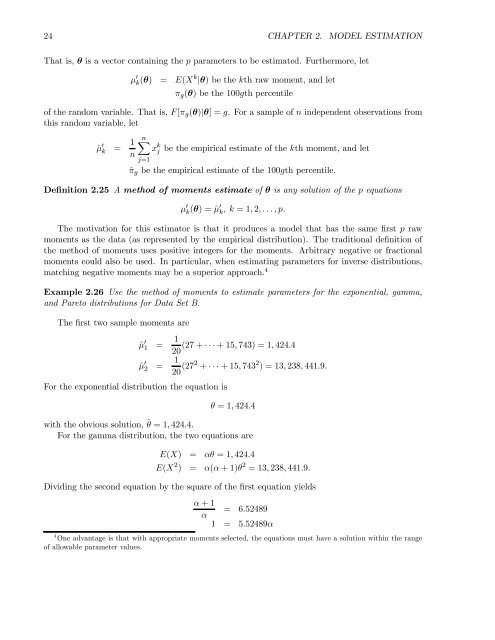Estimation, Evaluation, and Selection of Actuarial Models
Estimation, Evaluation, and Selection of Actuarial Models
Estimation, Evaluation, and Selection of Actuarial Models
Create successful ePaper yourself
Turn your PDF publications into a flip-book with our unique Google optimized e-Paper software.
24 CHAPTER 2. MODEL ESTIMATION<br />
That is, θ is a vector containing the p parameters to be estimated. Furthermore, let<br />
µ 0 k (θ) = E(Xk |θ) be the kth raw moment, <strong>and</strong> let<br />
π g (θ) be the 100gth percentile<br />
<strong>of</strong> the r<strong>and</strong>om variable. That is, F [π g (θ)|θ] =g. Forasample<strong>of</strong>n independent observations from<br />
this r<strong>and</strong>om variable, let<br />
ˆµ 0 k = 1 nX<br />
x k j be the empirical estimate <strong>of</strong> the kth moment, <strong>and</strong> let<br />
n<br />
j=1<br />
ˆπ g be the empirical estimate <strong>of</strong> the 100gth percentile.<br />
Definition 2.25 A method <strong>of</strong> moments estimate <strong>of</strong> θ is any solution <strong>of</strong> the p equations<br />
µ 0 k (θ) =ˆµ0 k , k =1, 2,...,p.<br />
The motivation for this estimator is that it produces a model that has the same first p raw<br />
moments as the data (as represented by the empirical distribution). The traditional definition <strong>of</strong><br />
the method <strong>of</strong> moments uses positive integers for the moments. Arbitrary negative or fractional<br />
moments could also be used. In particular, when estimating parameters for inverse distributions,<br />
matching negative moments may be a superior approach. 4<br />
Example 2.26 Use the method <strong>of</strong> moments to estimate parameters for the exponential, gamma,<br />
<strong>and</strong> Pareto distributions for Data Set B.<br />
The first two sample moments are<br />
For the exponential distribution the equation is<br />
ˆµ 0 1 = 1 (27 + ···+15, 743) = 1, 424.4<br />
20<br />
ˆµ 0 2 = 1 20 (272 + ···+15, 743 2 )=13, 238, 441.9.<br />
θ =1, 424.4<br />
with the obvious solution, ˆθ =1, 424.4.<br />
For the gamma distribution, the two equations are<br />
E(X) = αθ =1, 424.4<br />
E(X 2 ) = α(α +1)θ 2 =13, 238, 441.9.<br />
Dividing the second equation by the square <strong>of</strong> the first equation yields<br />
α +1<br />
α<br />
= 6.52489<br />
1 = 5.52489α<br />
4 One advantage is that with appropriate moments selected, the equations must have a solution within the range<br />
<strong>of</strong> allowable parameter values.
















